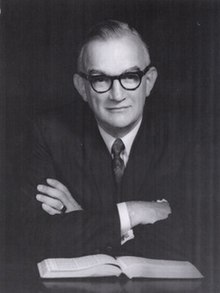Loading AI tools
American politician From Wikipedia, the free encyclopedia
John Phillips Saylor (July 23, 1908 – October 28, 1973) was a Republican member of the U.S. House of Representatives from Pennsylvania serving from 1949 until his death from a heart attack in Houston, Texas in 1973.
John Saylor | |
|---|---|
 | |
| Member of the U.S. House of Representatives from Pennsylvania | |
| In office September 13, 1949 – October 28, 1973 | |
| Preceded by | Robert Coffey |
| Succeeded by | John Murtha |
| Constituency | 26th district (1949–1953) 22nd district (1953–1973) 12th district (1973) |
| Personal details | |
| Born | July 23, 1908 Conemaugh Township, Somerset County, Pennsylvania, U.S. |
| Died | October 28, 1973 (aged 65) Houston, Texas, U.S. |
| Resting place | Grandview Cemetery 40.31170°N 78.92580°W |
| Political party | Republican |
| Spouse | Grace |
| Children | 2 |
| Alma mater | Franklin and Marshall College Dickinson School of Law |
Saylor was born in Conemaugh Township, Somerset County, Pennsylvania. He graduated from Franklin and Marshall College in Lancaster, Pennsylvania, in 1929, and Dickinson School of Law in Carlisle, Pennsylvania in 1933. He was elected city solicitor of Johnstown, Pennsylvania, in 1938 and served until 1940. He enlisted in the United States Navy on August 6, 1943 and served until January 1946.
Saylor was elected as a Republican to the 81st Congress, by special election, September 13, 1949, to fill the vacancy caused by the death of Robert L. Coffey. He was reelected to the twelve succeeding Congresses and served until his death in Houston, Texas. During his time in Congress he became dedicated to a number of environmental causes, including the Wilderness Act of 1964,[1] the Ozark National Scenic Riverways Act, National Wild and Scenic Rivers Act and in opposition to the Kinzua Dam Project.[2] He was dubbed "St. John" by environmental advocates for his dogged work on environmental issues.
In 1970 the Izaak Walton League of America bestowed its highest honor, the Founders' Award, to Saylor "for two decades of unprecedented leadership in the Congress of the United States for sound resource management, the preservation of natural scenic and cultural values, the maintenance of a quality environment, and the unalienable right of citizens to be involved in resources and environmental decisions."[3]
Saylor voted in favor of the Civil Rights Acts of 1957,[4] 1960,[5] 1964,[6] and 1968,[7] as well as the 24th Amendment to the U.S. Constitution and the Voting Rights Act of 1965.[8][9]
Saylor and his wife, Grace, had two children.[10]
On October 24, 1973, Saylor had surgery for an aortic aneurysm at St. Luke's Episcopal Hospital in Houston. While the operation was reported to be a success, he had a heart attack in his hospital room shortly after midnight on October 28 and died at the age of 65.[10] He is buried in Grandview Cemetery, Johnstown, Pennsylvania. The John P. Saylor Trail in Gallitzin State Forest is named after him.[11]
Seamless Wikipedia browsing. On steroids.
Every time you click a link to Wikipedia, Wiktionary or Wikiquote in your browser's search results, it will show the modern Wikiwand interface.
Wikiwand extension is a five stars, simple, with minimum permission required to keep your browsing private, safe and transparent.